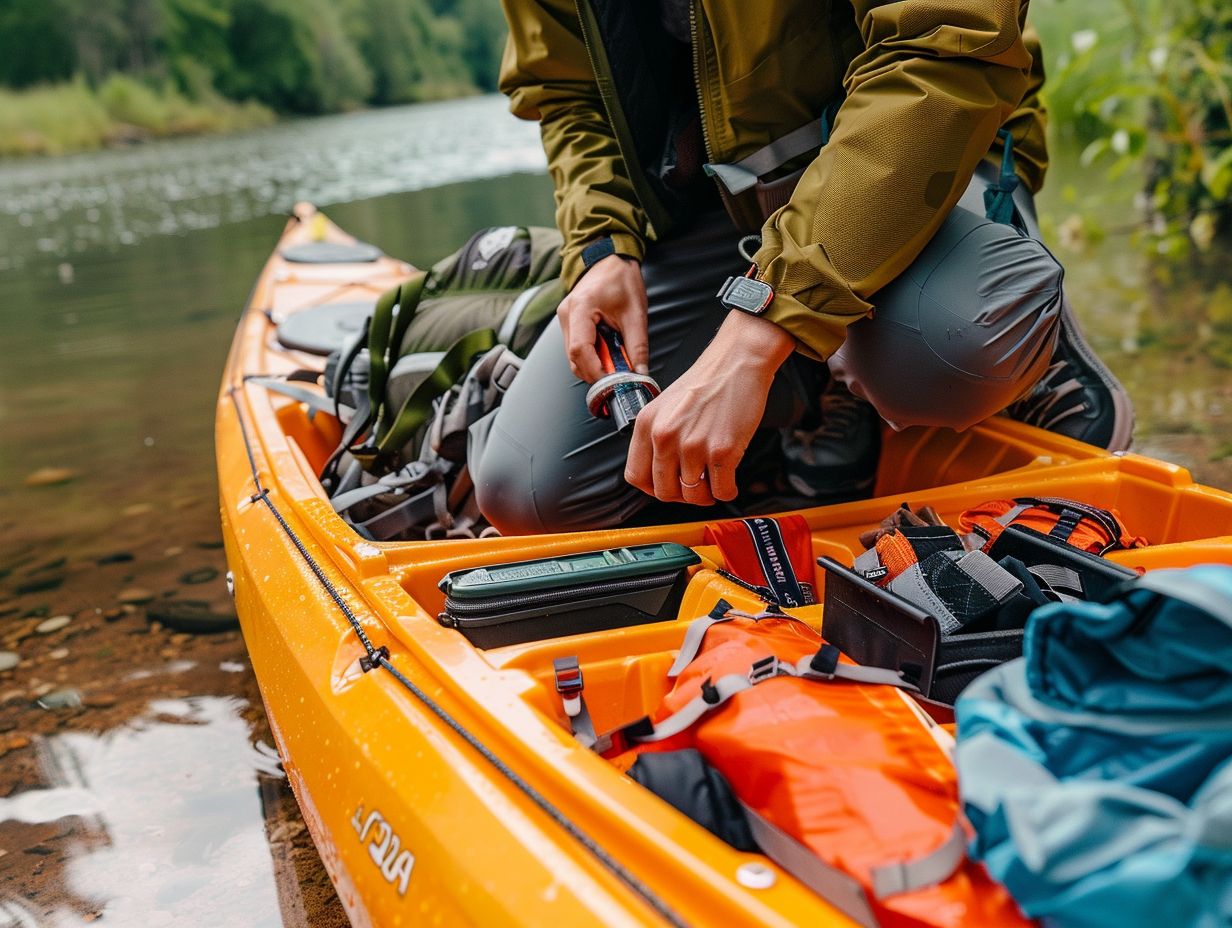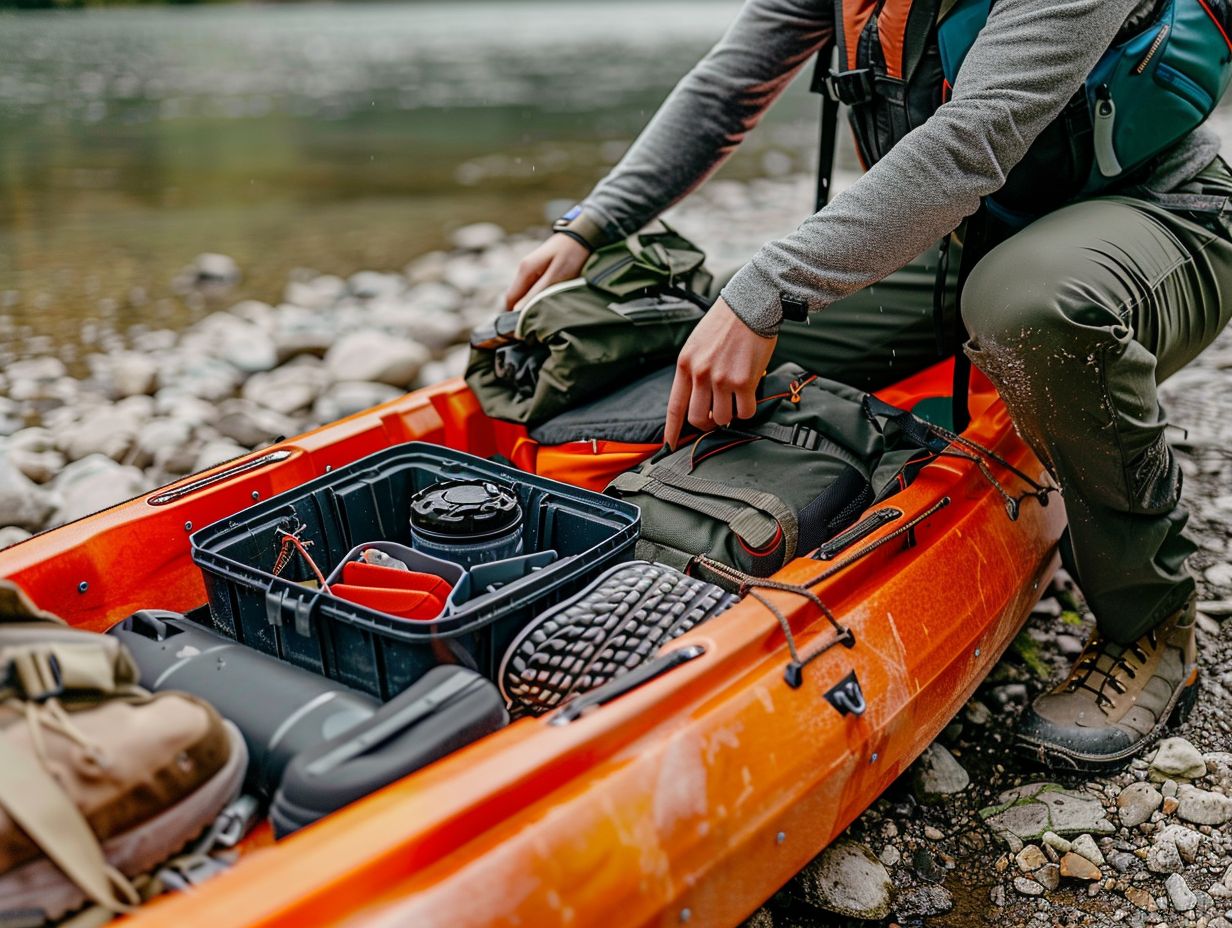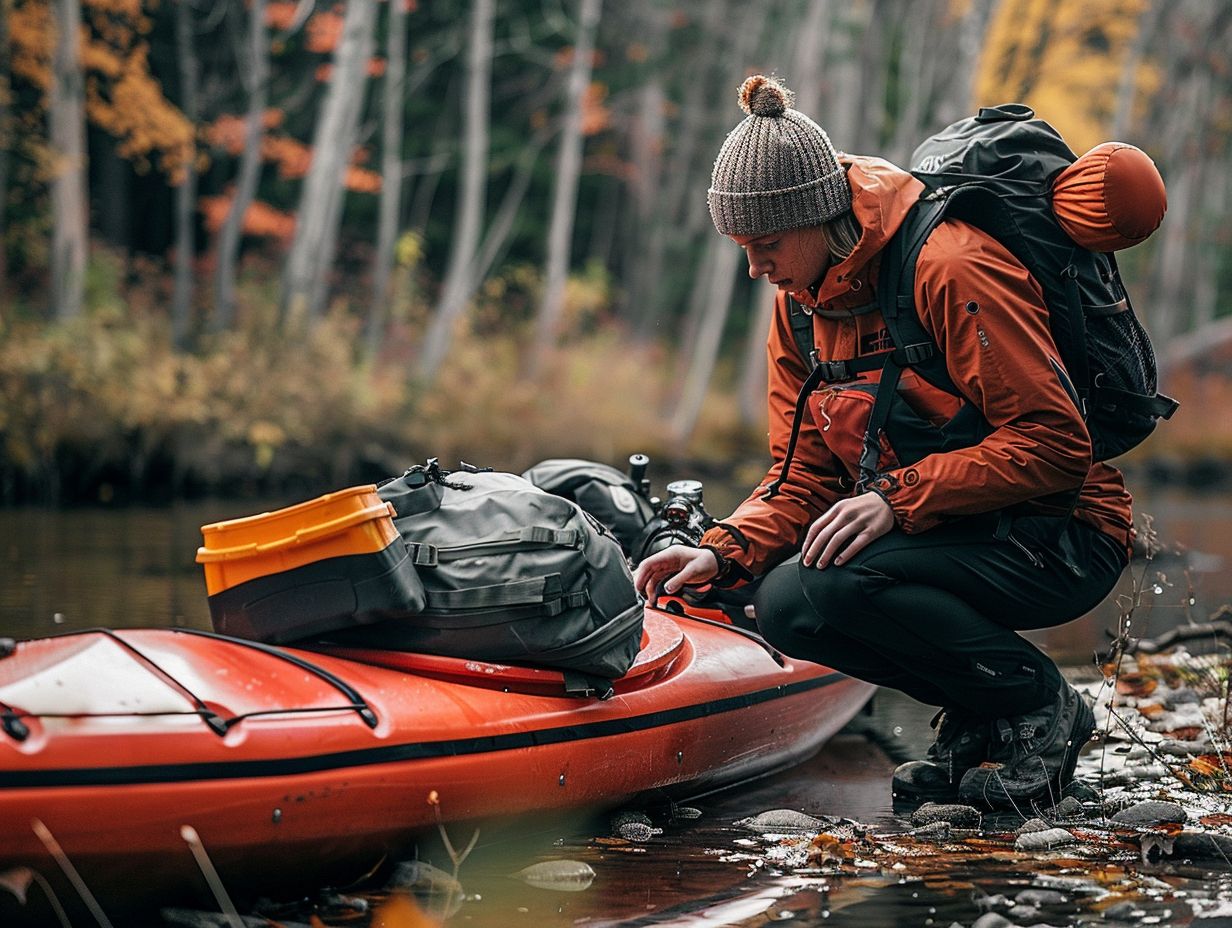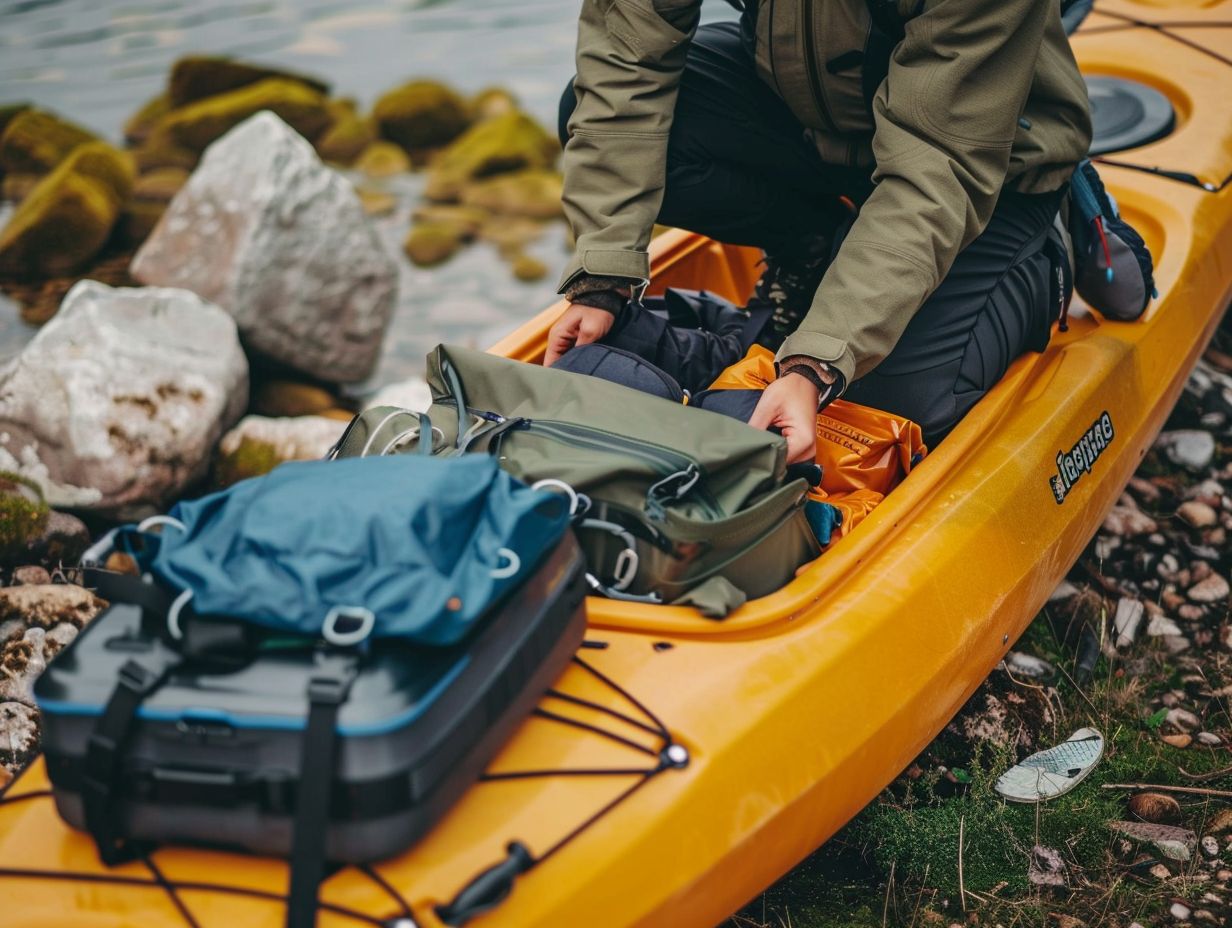If you are planning a kayaking camping trip and are uncertain about how to pack your gear efficiently, you have come to the right place.
The following strategies will be discussed for selecting the appropriate kayak, arranging your gear for quick access, waterproofing your essentials, and packing for various weather conditions.
From securing your gear for challenging waters to advice on solo kayak camping, all aspects will be covered. Ensure your safety and responsibility on the water by following our expert advice.
Key Takeaways:

- Choose the right kayak for camping based on its size, weight capacity, and stability to ensure a comfortable and safe trip.
- Pack essential gear such as a life jacket, first aid kit, and navigation tools for a kayak camping trip, and organize them for easy access and waterproof them for protection.
- Distribute weight evenly and secure gear for stability and maneuverability, and consider weather conditions and food and water needs when packing for a multi-day kayak camping trip.
Choosing the Right Kayak for Camping
When preparing for a kayak camping adventure, selecting the ideal kayak is crucial to ensure a comfortable and safe journey. You should consider factors like kayak type, size, and durability to match your camping needs.
Touring kayaks are great for longer trips due to their sleek design, efficiency in covering distances, and ample storage space for camping gear. On the other hand, inflatable kayaks offer easy transport and storage, making them convenient for camping trips that involve a lot of moving around.
Assessing a kayak’s stability in various water conditions and its storage capacity for your camping essentials are key aspects to focus on when choosing the right kayak for your adventure. According to Jeffrey Lee, an expert paddler, these considerations will help you select the most suitable kayak for your kayak camping experience.
Essential Gear for a Kayak Camping Trip
When embarking on a kayak camping expedition, ensuring you have the appropriate kit is crucial for a successful and enjoyable experience. Sea to Summit offers a selection of premium camping gear designed to provide comfort and functionality throughout your paddling journey.
Key kit essentials, such as drybags, are vital for keeping your belongings dry and well-organised while you are out on the water. A reliable camping stove, like the MSR WhisperLite, offers a convenient method for preparing hot meals following a strenuous day of paddling.
Navigation tools, such as the Garmin InReach Mini, play a critical role in staying connected and ensuring safety in the event of emergencies. Sea to Summit is a reputable brand recognised for its durable and reliable camping equipment, capable of enduring the rigours of outdoor adventures.
Organising Your Gear for Easy Access
Efficiently organising your camping gear in Flett bags can greatly enhance the success of your kayak camping trip. Ensuring proper bag allocation and labelling will facilitate easy access to crucial items as needed, ultimately improving the overall convenience of your expedition.
When organising your gear into Flett bags, it is advisable to group similar items together for better organisation. For instance, you can assign one bag for cooking essentials like portable stoves, fuel canisters, and cookware, while another bag can be designated for your dry clothes and sleeping gear. This systematic approach simplifies the packing process and enables you to locate items swiftly.
Placing heavier items strategically closer to the kayak’s centre of gravity can enhance stability while engaging in your paddling excursions. This adjustment can contribute to a smoother and more controlled experience during your outdoor adventures.
Packing Tips for Different Types of Kayaks
When packing efficiently for kayak camping, you should carefully consider your kayak type and weight capacity. It is advisable to opt for lightweight camping gear and compact essentials to ensure a well-balanced load that does not compromise your kayak’s stability and manoeuvrability.
Understanding the weight distribution within your kayak can significantly impact your overall paddling experience. For longer kayaking trips, it is important to focus on essential items such as food, water, safety gear, and clothing to prioritise what to pack.
Effectively utilising the available storage compartments by packing heavier items closer to the kayak’s centre of gravity can enhance stability. It is crucial to avoid overloading one side of the kayak, as this can lead to uneven weight distribution and affect performance.
By paying attention to these details, you can enjoy a more comfortable and efficient kayak camping adventure.
Distributing Weight for Stability and Maneuverability

Achieving the right balance of weight distribution in your kayak is crucial for maintaining stability and manoeuvrability while paddling. Expert advice recommends positioning heavy items low and central to optimise your kayak’s performance on the water.
When heavier items are placed closer to the centre of the kayak, it helps prevent the boat from becoming excessively top-heavy, reducing the risk of tipping over. Distributing weight evenly from front to back is another valuable tip to avoid creating imbalances that could affect steering.
It’s also beneficial to adjust your gear placement based on the paddling conditions. For instance, shifting weight towards the back can aid in navigating rough waters, while moving weight forward may improve speed in calmer conditions.
Waterproofing Your Gear
Protecting your clothing and essential items from water damage is essential during kayak camping trips. Utilising quality drybags for waterproof storage ensures that your gear remains dry and functional, even in wet conditions.
These drybags are specifically designed to safeguard your sensitive items, such as clothing, electronics, and camping supplies, from water intrusion.
By investing in reliable waterproofing gear, you not only extend the lifespan of your equipment but also enhance your overall camping experience.
Picture the peace of mind that comes from knowing your valuables are shielded from unexpected rainfall or accidental splashes. Whether you are navigating choppy waters or encountering unpredictable weather, having waterproof storage solutions can significantly impact the success of your outdoor adventures.
Packing for Different Weather Conditions
When preparing for a kayak camping trip, it is important to pack gear that can accommodate various weather conditions. Include water-resistant clothing, additional layers, and waterproof accessories to maintain comfort and safety in fluctuating weather environments.
Having adaptable gear that can cater to different situations on the water is crucial. Investing in items that can seamlessly transition from sunny to rainy conditions will elevate your overall experience.
Remember to pack emergency supplies such as a first aid kit, a fully charged portable phone charger, and extra food and water in case of unforeseen weather changes. Being equipped for any scenario will not only ensure your safety but also enable you to fully appreciate the natural beauty while kayaking.
Maximising Space in Your Kayak
Optimising space utilisation in your kayak is crucial for accommodating all necessary camping gear without overcrowding the vessel. Employing strategic packing techniques and selecting compact gear can help you maximise the available space for a more comfortable journey.
Consider rolling your clothes to save space efficiently. Not only does this minimise wrinkles, but it also creates more room within the storage compartments.
Nesting containers can also be utilised to stack smaller items neatly, saving valuable space in your kayak. Utilising compression sacks for bulkier items like sleeping bags or jackets can significantly reduce their size, enabling you to store them in compact spaces.
Lastly, remember to make use of every nook and cranny in your kayak for efficient storage – every corner can be utilised to ensure all your essentials are securely packed for your adventure.
Securing Your Gear for Rough Waters
Securing your kit properly is crucial to prevent loss or damage, especially when navigating rough waters during your kayak camping trip. Utilising tie-downs, bungee cords, and waterproof containers can help you keep your equipment safe and secure.
Tie-downs are a reliable method for anchoring larger items like chill boxes or marquees, securing them to your kayak’s deck to ensure stability.
Bungee cords are effective for keeping smaller kit in place, such as water bottles or dry sacks. When using waterproof containers, it’s essential to seal them tightly to prevent any water from seeping in. Additionally, consider investing in deck netting or storage bags to provide extra layers of security for your belongings.
By combining these methods and regularly checking the fastenings, you can ensure that your kit remains secure, regardless of the water conditions.
Packing for a Multi-Day Kayak Camping Trip

When preparing for a multi-day kayak camping adventure, you must engage in thoughtful planning and pack efficiently for your overnight stays. Ensure that essential items such as camping gear, food supplies, and safety equipment are organised effectively to support your paddling expedition.
When determining your food storage strategy for an extended kayak camping trip, it is advisable to select non-perishable items such as dehydrated meals, trail mix, and tinned goods. This choice minimises the risk of spoilage. To safeguard perishable items like fruit and vegetables, consider investing in airtight containers or dry bags.
Maintaining personal hygiene is crucial during your trip. Be sure to pack biodegradable soap, toothpaste, and a portable shower system.
In terms of emergency preparedness, include a first aid kit, emergency blanket, and a waterproof torch in your supplies. Proper waste disposal management is essential, so remember to bring along rubbish bags and always adhere to Leave No Trace principles.
Food and Water Considerations
Proper food and water planning are crucial aspects of a successful kayak camping experience. Ensuring an adequate supply of nutritious meals, hydration options, and water purification methods is essential for sustaining energy and health during your outdoor excursion.
Regarding menu planning for kayak camping, opting for lightweight meal options is key. Consider dehydrated foods, instant soups, energy bars, and trail mix that are easy to pack and require minimal cooking.
Compact cooking equipment, such as a portable camping stove and lightweight cookware, enables you to prepare hot meals without adding bulk to your gear. Knowing how to locate and safely utilise water sources along your route is essential.
Investing in a reliable water filtration system or water purification tablets can help you stay hydrated on the water while minimising the risk of illness.
Emergency Gear and First Aid Kit
When planning a kayak camping trip, ensuring safety includes prioritising emergency gear and a well-equipped first aid kit. Essential items such as communication devices, navigation tools, and medical supplies play a crucial role in potentially life-threatening situations.
For kayak camping adventures, a comprehensive emergency kit should also feature a waterproof torch with additional batteries, high-energy snacks, a multi-tool, waterproof matches, and a whistle for signalling emergencies.
Additionally, packing a portable water filter or water purification tablets can guarantee a safe drinking water supply during unexpected events.
Regarding communication protocols, it is vital to have a waterproof mobile phone case or a handheld VHF marine radio to contact for help when necessary. Basic first aid skills, such as treating cuts, burns, sprains, and bites, should be well-known to all members of the kayaking group.
Properly Loading and Unloading Your Kayak
Mastering the art of loading and unloading your kayak efficiently is crucial for ensuring a seamless beginning and end to your camping expedition. Employing proper techniques for balancing weight distribution and securing gear is key to facilitating safe and smooth transitions on and off the water.
To start, it is important to organise your gear based on its weight and dimensions. Place heavier items towards the centre of the kayak to maintain equilibrium.
Secure larger equipment, such as tents or coolers, in the designated storage compartments of the kayak to prevent any movement that might impede your paddling. Use bungee cords or straps to fasten items like dry bags, sleeping bags and cooking supplies onto the kayak’s deck.
Additionally, remember to verify the kayak’s weight capacity and evenly distribute the gear. When unloading, reverse the process by removing the heavier items first followed by the lighter gear. Always handle your kayak with care both on and off the water to extend its longevity and ensure safety during your travels.
Tips for Solo Kayak Camping
Embarking on a solo kayak camping adventure can be a rewarding and introspective experience for you, but it requires meticulous planning and preparation. As a solo camper, you should prioritize safety, communication, and self-reliance to ensure a successful and enjoyable journey.
When planning a kayak camping trip alone, it is important for you to start by selecting a suitable location that aligns with your skill level and experience. Conduct thorough research on the area’s regulations, weather conditions, and wildlife to avoid any unexpected surprises during your expedition.
It is crucial that you inform someone of your planned itinerary, including your route, expected return time, and emergency contacts. Packing essential safety gear such as a first aid kit, navigation tools, and emergency communication devices is a necessity for your trip.
Select a sturdy and stable kayak, and make sure to practice basic self-rescue techniques before you set out on your adventure. Establishing a routine while camping solo can help alleviate any feelings of isolation; engaging in activities like journaling, meditating, or preparing a special meal can bring a sense of normalcy and comfort to your camping experience.
Staying Safe and Responsible on the Water

Maintaining safety and responsible behaviour while on the water is essential for a positive kayak camping experience. Whether you are paddling near Angel Island in San Francisco Bay or exploring remote waterways, observing water safety practices and environmental conservation guidelines is crucial.
Navigating diverse water environments such as tidal waters and the open sea requires extra caution and preparation. Tidal waters can bring strong currents and unpredictable conditions, so it is vital to check tide charts and plan outings accordingly. Similarly, venturing into the open sea demands a higher level of skill and awareness due to potential waves and changing weather patterns.
By adhering to Leave No Trace principles, kayakers can help preserve the natural beauty of the areas they explore and minimise their impact on delicate ecosystems.
Frequently Asked Questions
What are the best strategies for packing a kayak for camping?
The best strategies for packing a kayak for camping include organizing your gear, balancing the weight, utilising dry bags, and securing the items in the kayak.
How should I organize my gear when packing a kayak for camping?
Organising your gear is crucial when packing a kayak for camping. Start by categorising your items into groups, such as cooking supplies, clothing, and sleeping gear. Then, pack the heaviest items in the bottom of the kayak and lighter items on top.
What is the importance of balancing the weight when packing a kayak for camping?
Balancing the weight of your gear in the kayak is essential for stability and safety on the water. Ensure that the weight is evenly distributed from front to back and left to right to prevent the kayak from tipping over.
Why should I use dry bags when packing a kayak for camping?
Dry bags are essential for keeping your gear dry and protected while kayaking. They come in various sizes and can be used to store clothes, food, electronics, and other items that need to stay dry.
How can I secure my items in the kayak while camping?
To prevent your gear from shifting or falling out of the kayak, use bungee cords or straps to secure them in place. It’s also helpful to pack items in waterproof containers or bags to prevent them from getting wet in case of splashing or rain.
What are some additional tips for packing a kayak for camping?
Some additional tips for packing a kayak for camping include taking only essential items, packing light and compact gear, and leaving room for emergency items such as first aid kits and communication devices. It’s also important to evenly distribute the weight among all passengers in the kayak for better stability.



